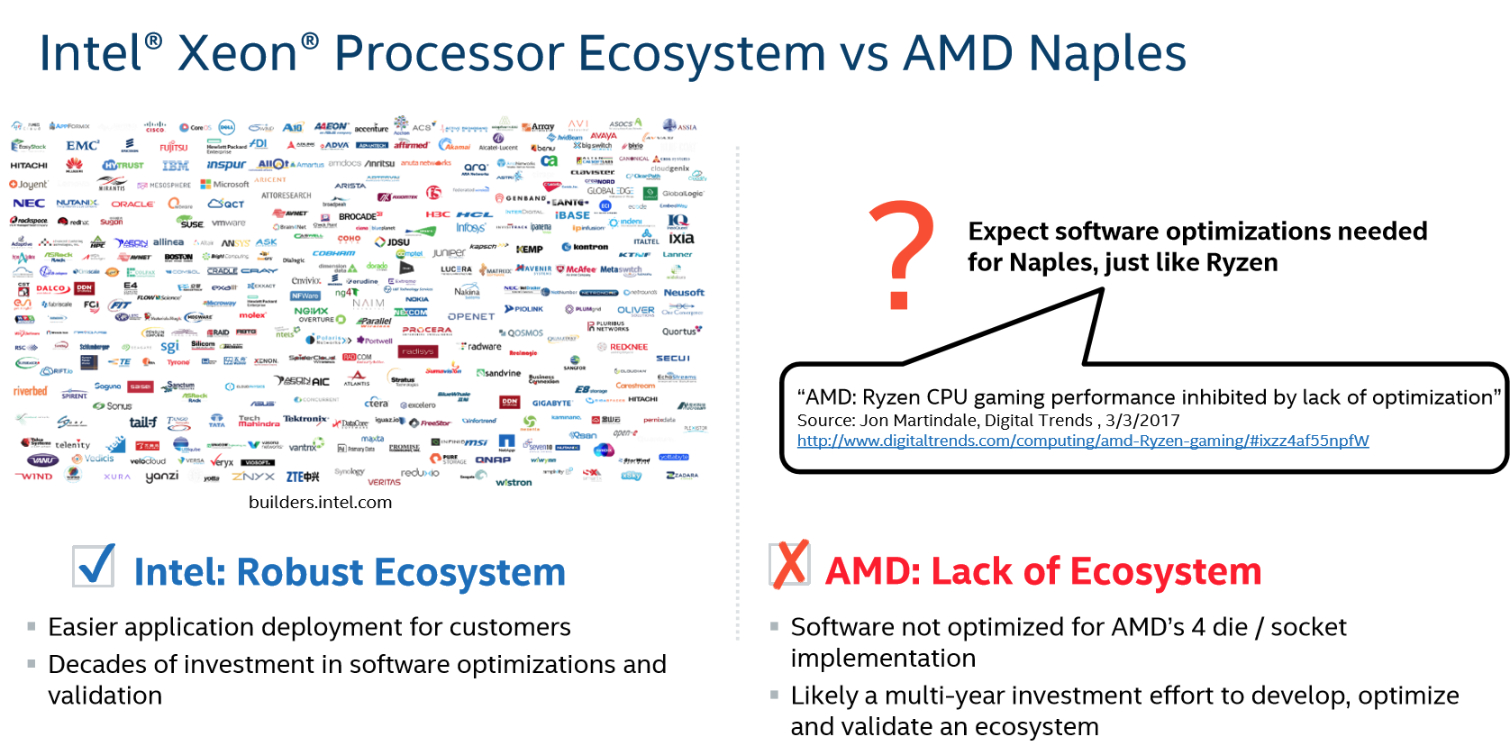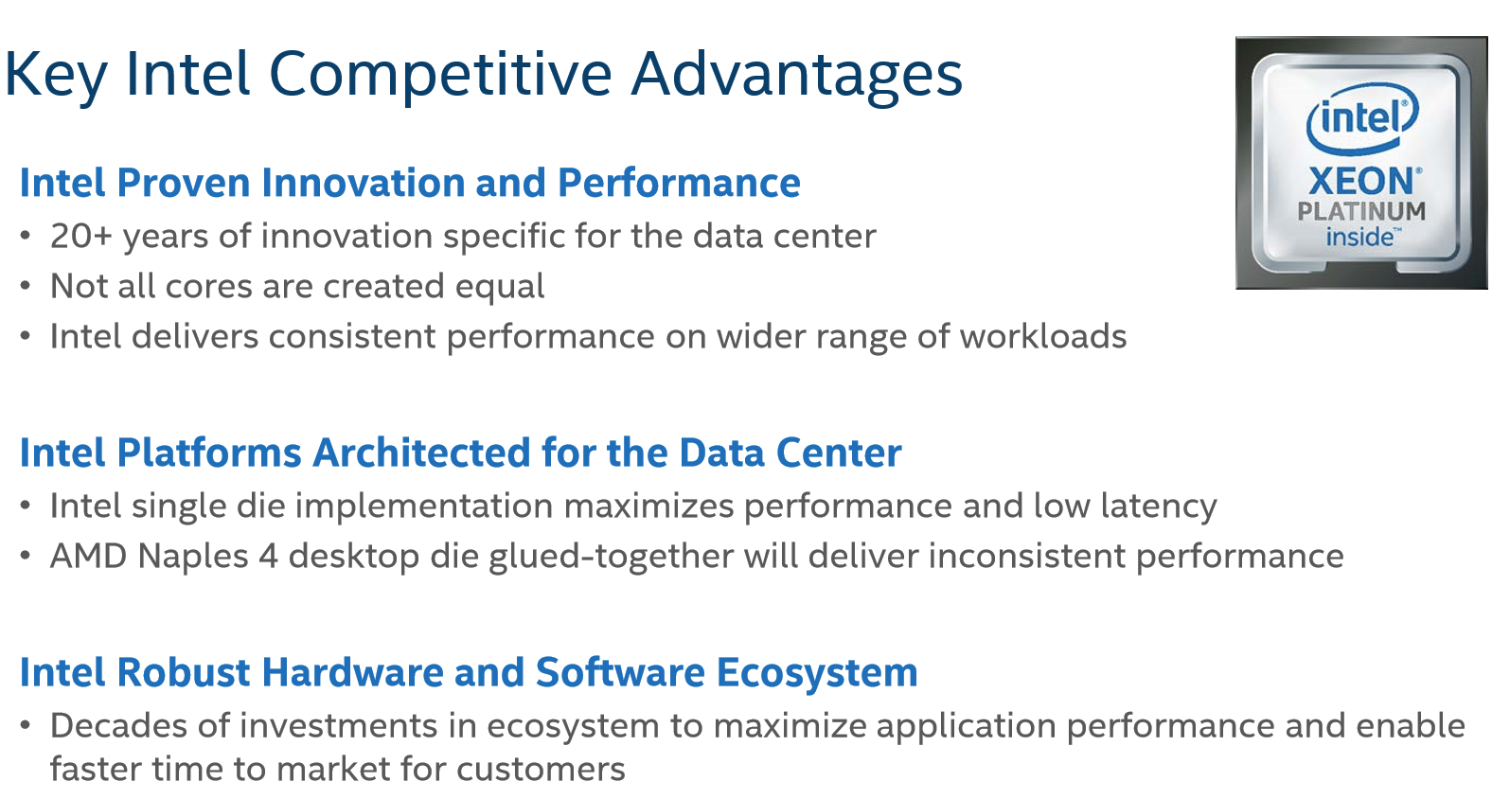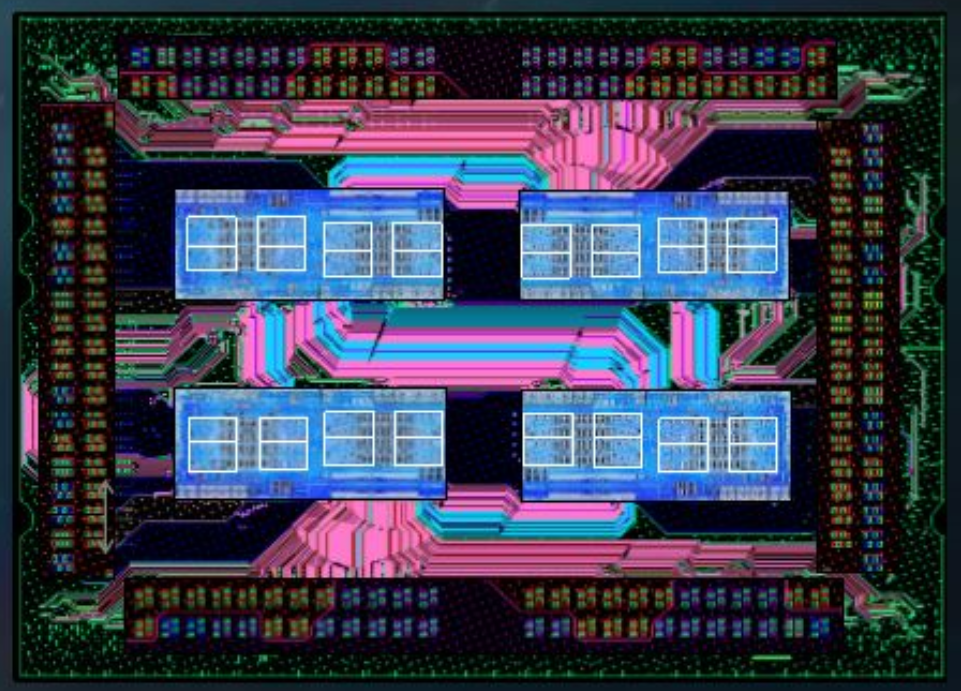Intel Plays Defense: Inside Its EPYC Slide Deck
Gaming Data Center Performance & Final Thoughts
Intel touted its impressive ecosystem as a big advantage, and noted that AMD's lack of an established infrastructure would hamper optimization efforts for its four-die architecture. AMD does have a smaller group of partners, but if it offers the right value-to-performance ratio, we expect it could enjoy similar long-term success. A few sharp-eyed redditors also noticed that Intel duplicated three of the logos on the chart, though that was likely unintentional.


AMD's lack of gaming optimization at launch was cited by Intel as an indicator that EPYC would begin its life similarly flat-footed, necessitating a similar optimization period for enterprise-oriented apps. Of course, that's an odd claim, in our opinion, considering Intel's statements to us about the impact of Skylake-X's mesh on some games:
Tom's Hardware: Again, as you'll see in our benchmarks, we ran into some strange performance trends that didn't add up. Given Skylake-X's frequency advantage, reworked cache, and 2D mesh topology, we didn't expect Broadwell-E to stand a chance. But in some cases, the previous-gen flagship outperformed Core i9-7900X. Asked about these anomalies, Intel responded:
Intel: On the Skylake-X part, we have noticed that there are a handful of applications where the Broadwell-E part is comparable or faster than the Skylake-X part. These inversions are a result of the “mesh” architecture on Skylake-X vs. the “ring” architecture of Broadwell-E.Every new architecture implementation requires architects to make engineering tradeoffs with the goal of improving the overall performance of the platform. The “mesh” architecture on Skylake-X is no different. While these tradeoffs impact a handful of applications; overall, the new Skylake-X processors offer excellent IPC execution and significant performance gains across a variety of applications.
We asked Intel if similar software optimizations could yield better performance:
Intel: Software tuning for the new architectural enhancements and cache hierarchy could improve performance.
Core i9-7900X uses the same core and mesh design as the Intel Scalable Processor family, so it's easy to contend that these same issues might affect Intel's Purley processor in some workloads.
Get Tom's Hardware's best news and in-depth reviews, straight to your inbox.
The final slide includes Intel's summation of its talking points, and the company stated, again, its key concept that "not all cores are created equal."
Our Thoughts
It's easy to see why the slides are generating controversy. Taken in context, Intel's claims do have some technical merit that we'll have to explore in more detail. But other points are more educated guesses than definitive conclusions.
In other areas, Intel may have simply spoken too soon. VM interoperability, for instance, may be a challenge for AMD at first. However, we've since learned that the company is already partnering with the major hypervisor vendors. This may help smooth over any performance issues before EPYC goes on sale. While it's true that AMD doesn't have an ecosystem to match Intel's, EPYC is collecting quite the list of supporters. It's possible that Intel also underestimated EPYC's management features.
Many consider the glued-together desktop die messaging to be ill-conceived from a company that also repurposes enterprise silicon for desktop PCs. It could be argued that AMD designed its Zeppelin die for data centers, an opinion we've voiced several times, and uses the same tactic of sharing it with the desktop models.
The war between Intel and AMD is certainly getting interesting. And in some ways, the most recent battle appears to be fought with interconnects. Intel's mesh architecture and AMD's Infinity Fabric will power both companies' respective platforms for years to come. AMD's advantage here may be that it sells CPUs and GPUs, playing to its heterogeneous compute strategy. That could make the foundational work behind Infinity Fabric shine in the months and years to come.
Now, nobody is arguing that AMD's design is without faults. But there are also some inherent benefits. For instance, the Infinity Fabric allows AMD to use smaller dies and cluster them together into larger packages. This mitigates the risk that goes into manufacturing complex, monolithic processors, potentially improving yields and keeping costs in check. It also helps the company increase volume at a time when it's going to want plenty of supply. It's a smart strategy for a fabless company that doesn't have Intel's R&D budget to throw around. AMD is focusing on the areas that play to its strengths and avoiding segments that aren't a good fit for the new architecture, which is admits frankly.
It's interesting that Intel did not focus on AMD's comparatively higher TDPs during its workshop. That is one of the most important concerns in the data center, as greater efficiency reduces total cost of ownership. Early testing indicates EPYC processors may have competitive power attributes, despite their higher TDP ratings, likely due to fine-grained power optimizations.
Intel is usually nonplussed in the face of competition. But its reaction to EPYC speaks volumes. In the end, absolute performance isn't nearly as important as the price-to-performance ratio, and initial signs indicate that AMD is off to a good start. AMD has scrapped its way through the last several years selling mostly budget parts, so any market gains are a win. Significant data center penetration could be a watershed moment for the company and fuel more investment in future products.
Conversely, Intel already delivers compelling performance, and its mature ecosystem will be hard for AMD to outshine. But the industry is pining for a suitable low-cost alternative, and if AMD's EPYC delivers, Intel's strengths might not be able to hold it off.
MORE: Best CPUs
MORE: Intel & AMD Processor Hierarchy
MORE: All CPUs Content
Current page: Gaming Data Center Performance & Final Thoughts
Prev Page Memory & Bandwidth Projections
Paul Alcorn is the Editor-in-Chief for Tom's Hardware US. He also writes news and reviews on CPUs, storage, and enterprise hardware.
-
Aspiring techie This is something I'd expect from some run-of-the-mill company, not Chipzilla. Shame on you Intel.Reply -
bloodroses Just like every political race, here comes the mudslinging. It very well could be true that Intel's Data Center is better than AMD's Naples, but there's no fact from what this article shows. Instead of trying to use buzzwords only like shown in the image, back it up. Until then, it sounds like AMD actually is onto something and Intel actually is scared. If AMD is onto something, then try to innovate to compete instead of just slamming.Reply -
redgarl LOL... seriously... track record...? Track record of what? Track record of ripping off your customers Intel?Reply
Phhh, your platform is getting trash in floating point calculation... 50%. And thanks for the thermal paste on your high end chips... no thermal problems involved. -
InvalidError Reply
To be fair, many of those "cheap shots" were fired before AMD announced or clarified the features Intel pointed fingers at.19950405 said:All I see is cheap-shots, kind of low for Intel.
That said, the number of features EPYC mysteriously gained over Ryzen and ThreadRipper show how much extra stuff got packed into the Zeppelin die. That explains why the CCXs only account for ~2/3 of the die size. -
redgarl To Intel, PCIe Lanes are important in today technology push... why?... because of discrete GPUs... something you don't do. AMD knows it, they knows that multi-GPU is the goal for AI, crypto and Neural Network. This is what happening when you don't expend your horizon.Reply
It's taking us back to the old A64. -
-Fran- It's funny...Reply
- They quote WTFBBQTech.
- Use the word "desktop die" all over the place without batting an eye on their own "extreme" platform being handicapped Xeons.
- No word on security features. I guess omission is also a "pass" in this case.
This reads more like a scare threat to all their customers out there instead of trying to sell a product. Miss Lisa Su is doing a good job it seems.
Cheers! -
InvalidError Reply
The extra server-centric stuff (crypto superviser, the ability for PCIe lane to also handle SATA and die-to-die interconnect, the 16 extra PCIe lanes per die, etc.) in Zeppelin didn't magically appear when AMD put EPYC together... so technically, Ryzen chips are crippled EPYC/ThreadRipper dies.19950713 said:- Use the word "desktop die" all over the place without batting an eye on their own "extreme" platform being handicapped Xeons.
-
-Fran- Reply19950773 said:
The extra server-centric stuff (crypto superviser, the ability for PCIe lane to also handle SATA and die-to-die interconnect, the 16 extra PCIe lanes per die, etc.) in Zeppelin didn't magically appear when AMD put EPYC together... so technically, Ryzen chips are crippled EPYC/ThreadRipper dies.19950713 said:- Use the word "desktop die" all over the place without batting an eye on their own "extreme" platform being handicapped Xeons.
I don't know if you're agreeing or not... LOL.
Cheers!

